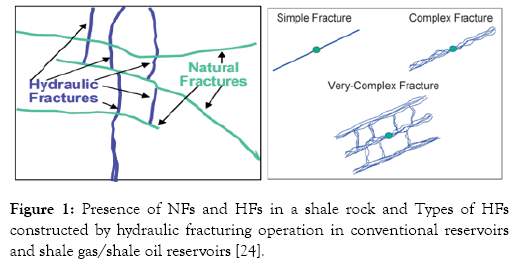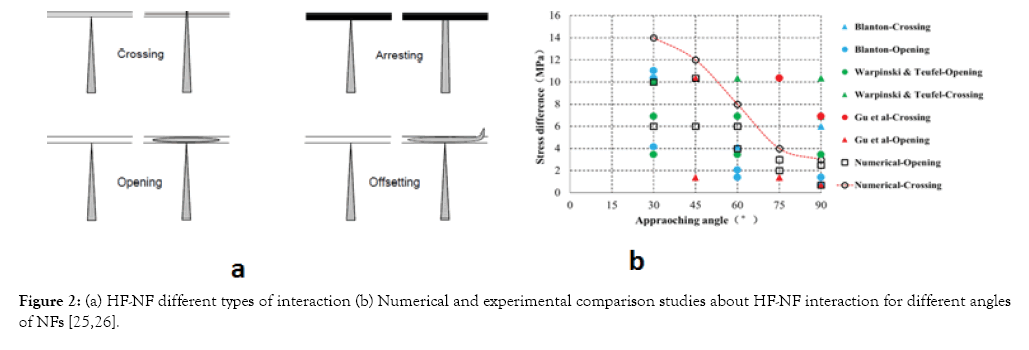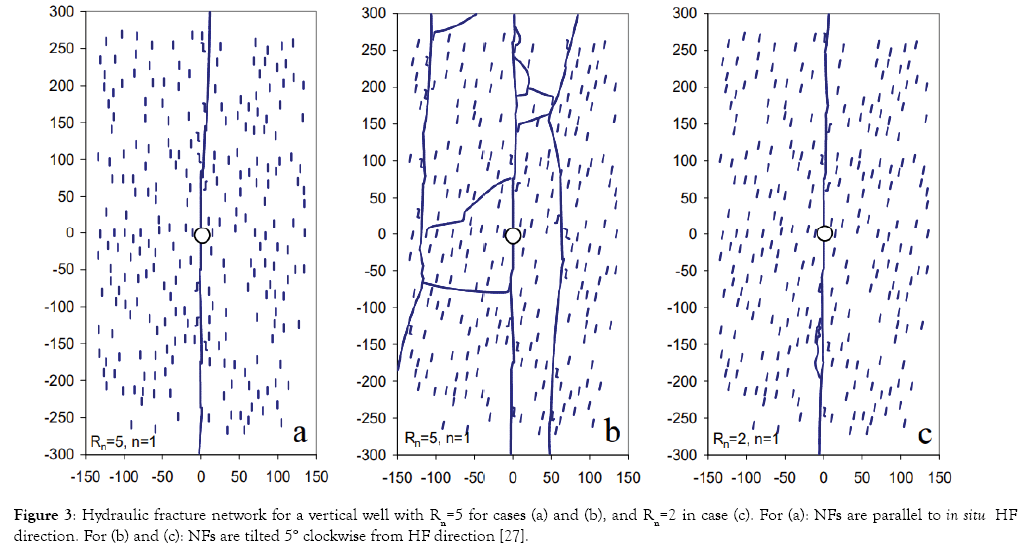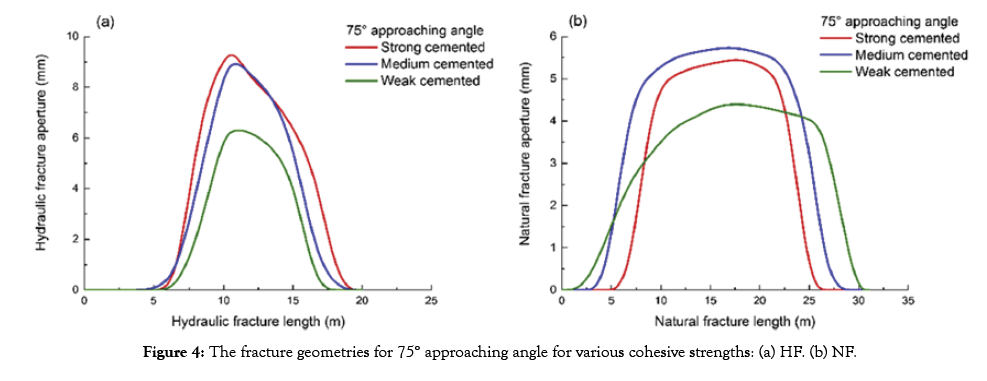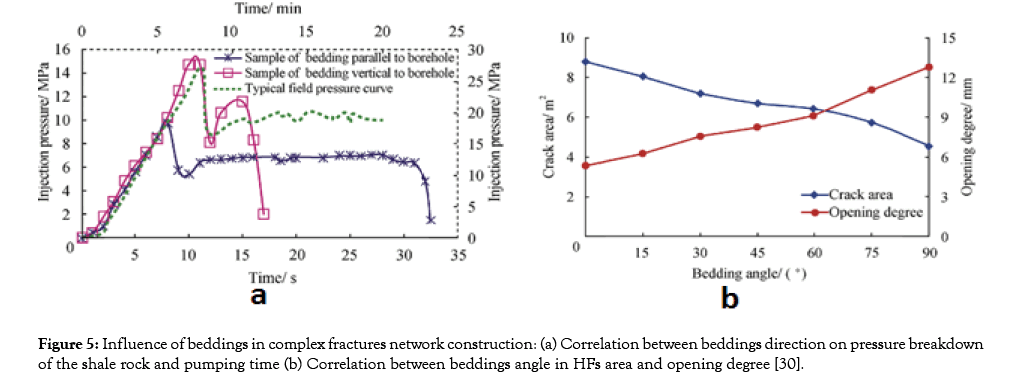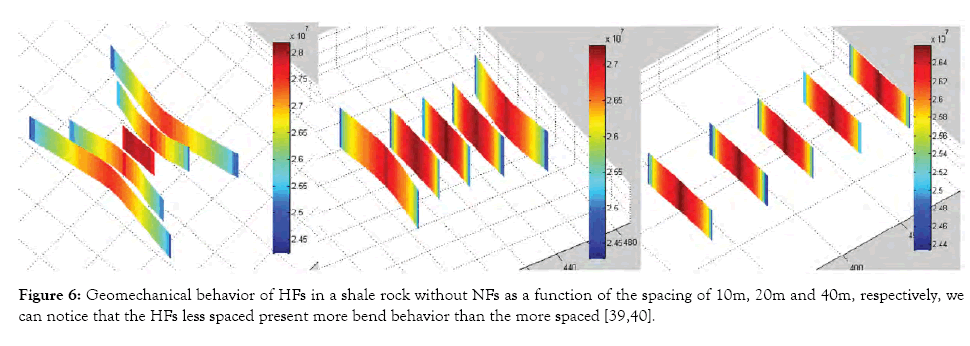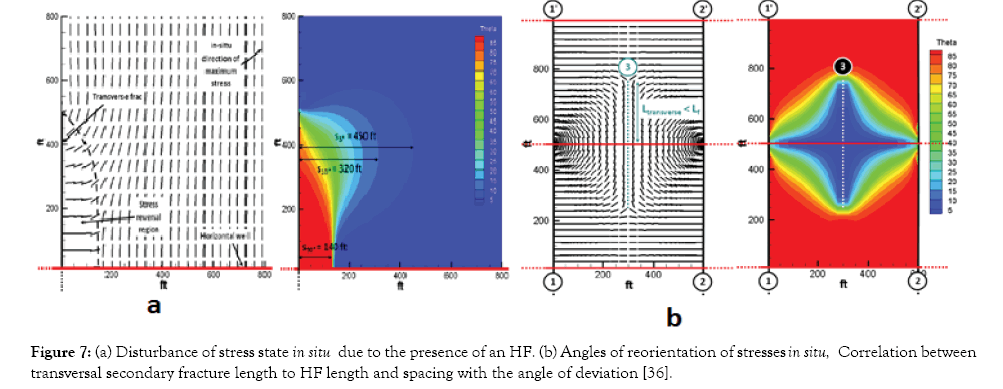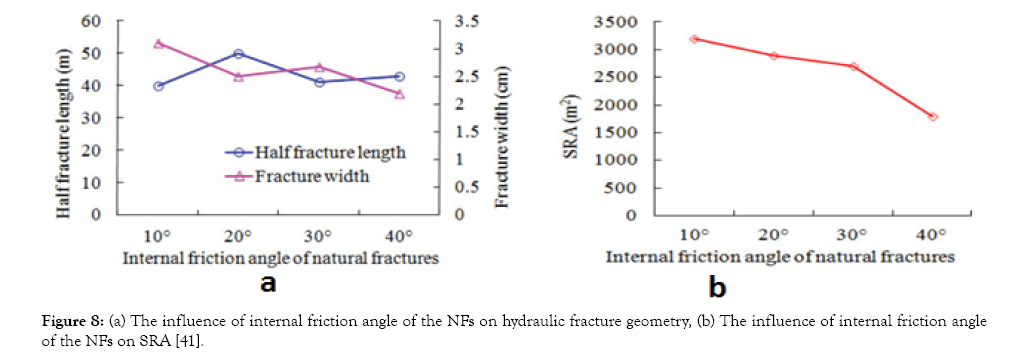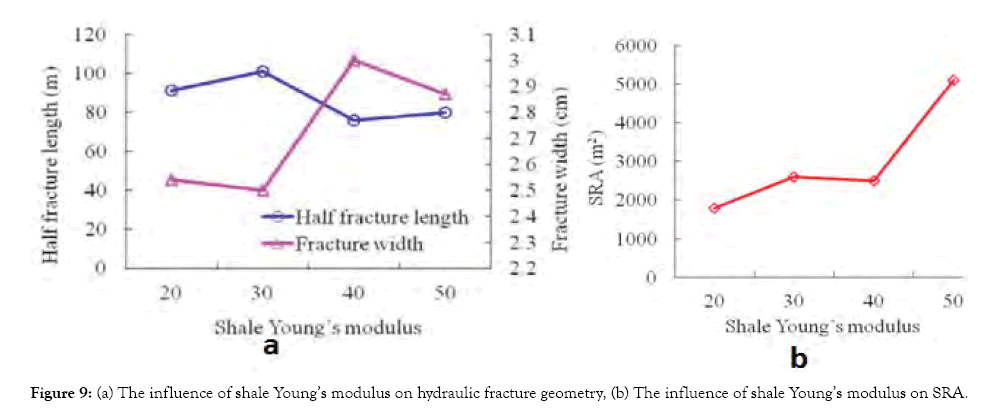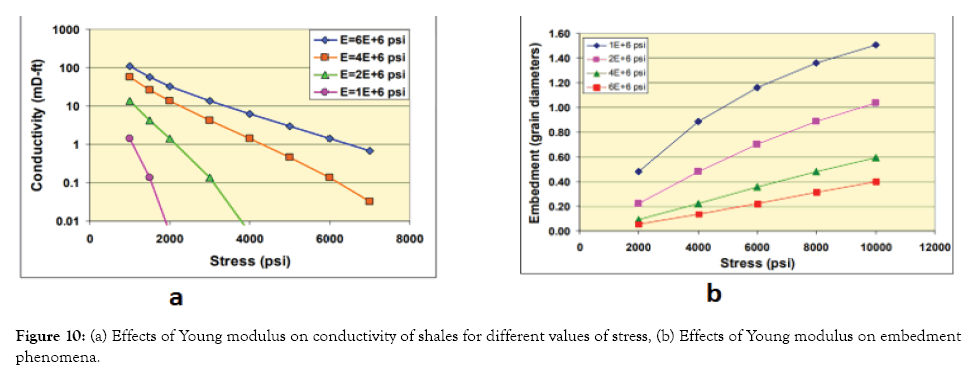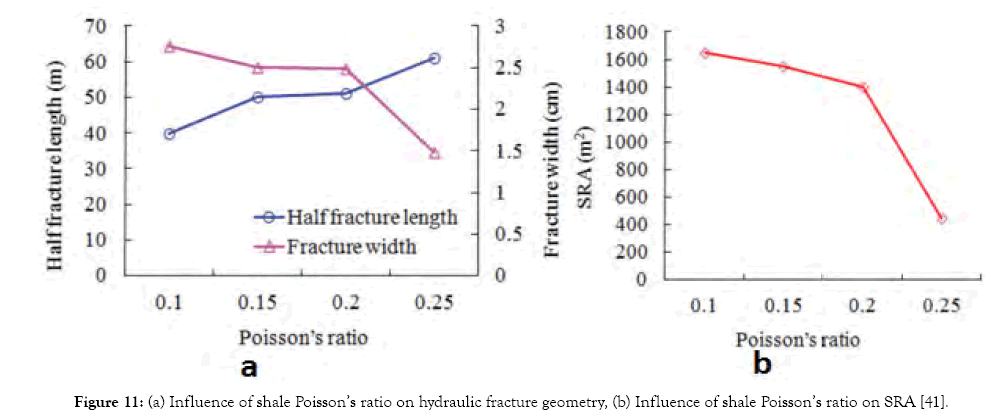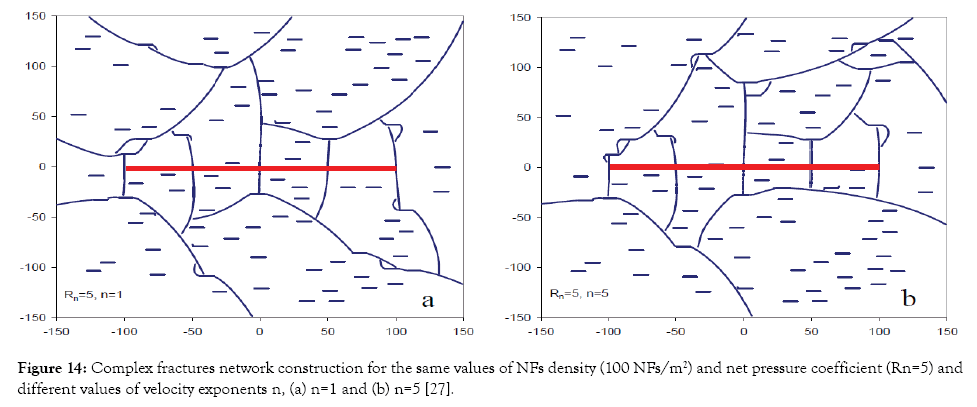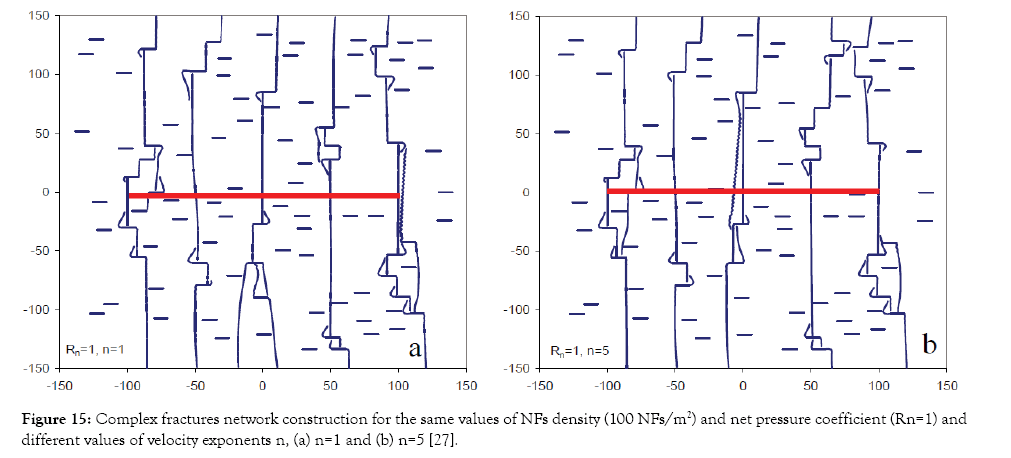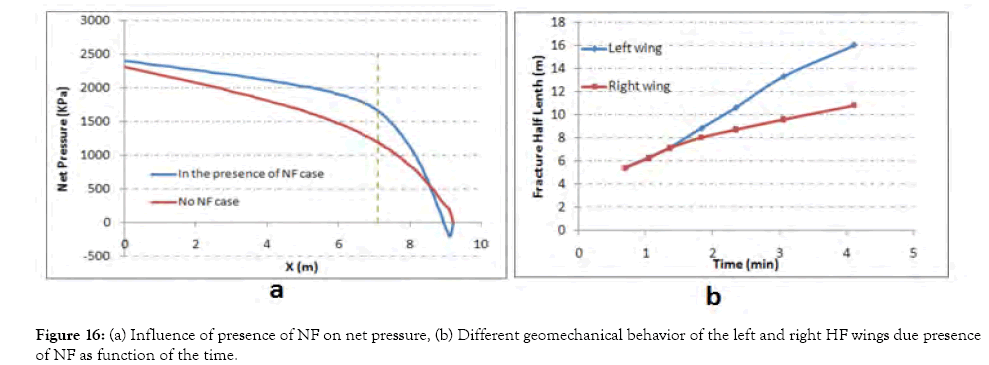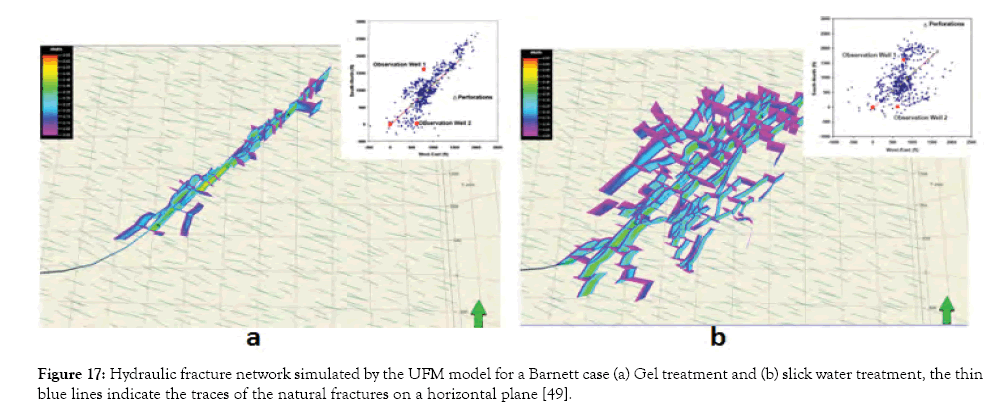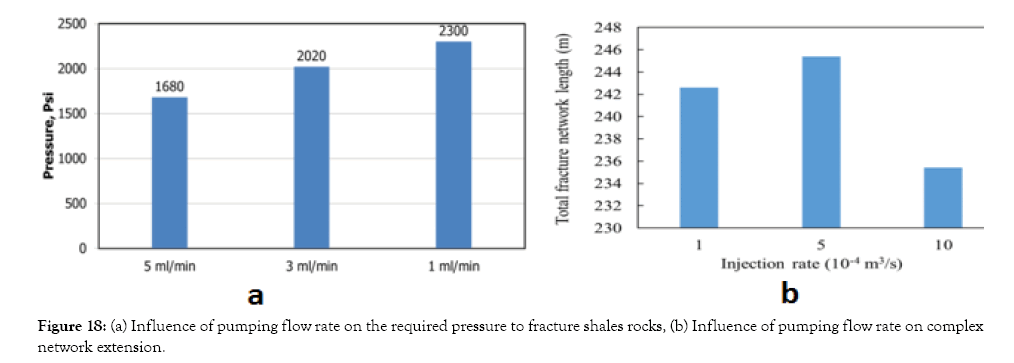Indexed In
- Open J Gate
- Genamics JournalSeek
- JournalTOCs
- China National Knowledge Infrastructure (CNKI)
- Electronic Journals Library
- RefSeek
- Hamdard University
- EBSCO A-Z
- OCLC- WorldCat
- SWB online catalog
- Virtual Library of Biology (vifabio)
- Publons
- MIAR
- Euro Pub
- Google Scholar
Useful Links
Share This Page
Journal Flyer

Open Access Journals
- Agri and Aquaculture
- Biochemistry
- Bioinformatics & Systems Biology
- Business & Management
- Chemistry
- Clinical Sciences
- Engineering
- Food & Nutrition
- General Science
- Genetics & Molecular Biology
- Immunology & Microbiology
- Medical Sciences
- Neuroscience & Psychology
- Nursing & Health Care
- Pharmaceutical Sciences
Review Article - (2020) Volume 11, Issue 1
Hydraulics and Geomechanics Parameters for Hydraulic Fracturing Optimization in Production's Developments of Shale Gas/ Shale Oil in North America
Fernando Bastos Fernandes1,2,3*, Wellington Campos1, Marcelo Otaviano Alves Botelho2 and Luiz Felipe de Queiroz Ferreira Braga12Petróleo Brasileiro S.A. (Petrobras), Rio de Janeiro, RJ - 20031-912, Brazil
Received: 09-Jan-2020 Published: 31-Jan-2020, DOI: 10.35248/2157-7463.20.11.399
Abstract
Unconventional reservoirs (NCR) have been responsible for an important revolution in the volume and profile of gas production in the USA and are now arousing interest of other countries e.g. China, Canada, Argentina and Australia. In most of the NCR, the development of production has been made possible through horizontal wells with multiple transverse fractures. In order to optimize the well hydraulic fracturing design for exploration and production’s development of shale gas/shale oil, is required to understand the key parameters that influence in the complex fractures network. In terms of reservoir stimulation through horizontal wells, the practice by smaller operators came before the theory, generating nice results and promoting theoretical development. The recent join of big operators into the unconventional reservoirs environment raised about the huge volumes of fluids and propping agents used in the complex fractures network, have generated some questions about shale gas/shale oil well stimulation. This work presents the main parameters that have influence on the complex fractures network built in shales, aiming to understand their effects in shale rock in order to avoid problems and optimize the hydraulic fracturing design.
Keywords
Shales reservoirs; Organic matter; Source rocks; Conventional reservoirs; Non-conventional reservoirs
Introduction
Shale gas/shale oil reservoirs have a significant amount of world hydrocarbon reserves and therefore has a huge importance for the global energetic matrix supply. The generation of petroleum occurs in sedimentary basins such as lakes, oceans, rivers and marshes, where sedimentary rocks with large amounts of ne grains, clay and silt are deposited over millions of years and carrying a certain volume of organic matter accumulated in the interior of their pores, [1] Such rocks are called source rocks, [2] After the maturation of the organic matter present in the source rock, a natural fracture occurs in the same one, due to the conditions of high pressure and temperature providing an ideal generation window and generating the primary migration of the hydrocarbon for its later imprisonment in a rock with high permo-porous properties, denominated rock reservoir, [3] The next step of the conventional petroleum system generating mechanism is to surround the reservoir by means of traps and a sealant rock, i.e., with low permeability, e.g. evaporite (salt) or shale itself, thereby preventing the hydrocarbon be drained to other layers [3].
The shale gas/shale oil system is different from the conventional reservoirs (CR) mentioned above, since shales are part of a group known in the literature as non-conventional reservoirs (NCR), because the primary migration has not yet occurred and also, because the shales have low permo-porous properties. Thus, the drilling operation is done directly on the source rock, so the shales are classified as source-reservoir rocks (SRR), [4] The ultra-low permeability and various gas accumulation features render the shale gas reservoirs difficult to be developed without hydraulic fracturing treatment, except a few with highly developed natural fracture networks [5] With the global commercial development of unconventional hydrocarbon reservoirs with low porosity and permeability, hydraulic fracturing has been one of common practices and major methods for reservoir stimulation [6].
The research of natural fractures shows that there are not many open NFs in shale reservoirs [7] because most of the pre-existing natural fractures are sealed by cementing materials during the diagenetic process. However, as the weak parts, these fractures can be reactivated to increase the effectiveness of hydraulic fracturing treatment.
Literature Review
NFs provide the accumulation space for natural gas. Hydraulic fracturing stimulates also NFs. Some NFs are opened and the conductivity in these fractures is greatly increased. If injected proppant reaches into the reactivated natural fractures, gas production will be greatly enhanced [8]. By around 2012, more than 55,000 wells have been drilled in shale gas reservoirs in the USA and as many wells are drilled for the development of an area, reducing the cost of well construction is an important aspect to be considered in a project of exploration and development of the production of shale gas/oil reservoirs, especially when the selling price of the gas/oil falls [9].
Normally, routinized and optimized operations are adopted and often improved, based on studies in specific areas. These studies are usually done through partnerships between operators and suppliers [10].
Shales proprieties
The structure of the shales is formed by clastic or detritic rocks. Its formation is by transport by water or air. Such rocks are normally composed of silica (e.g. quartz), combined with other common minerals such as feldspar and clay minerals e.g. quartz, limestone and feldspar, which have low particle size, making it difficult to exploit unused shale gas/shale oil of stimulation techniques. Another characteristic of shales is their high total organic content TOC [11]. A shale-gas reservoir primarily consists in three main types of porous media: organic matter, inorganic matter and natural fractures; where a fourth type called hydraulic/induced fractures occurs during hydraulic stimulation. It must be mentioned that, gas desorption and diffusion are the dominant physics in the organic matter or kerogen, where the organic content is expressed in terms of TOC [12]
The shale reservoir properties are critical factors determining fracture network generation, e.g. mineral composition, rock mechanical properties, horizontal stress difference and natural fracture properties. Brittle mineral-rich shale is beneficial in maximizing fracture complexity, whereas high clay mineral content is harmful in stimulating the reservoir [13,14] listed four conditions that made fracture complexity in the Barnett shale a desired and possible outcome: extremely low matrix permeability, low Poisson’s ratio, low horizontal stress difference, and orthogonal regional tensile fractures. The importance of natural fractures in shale for hydraulic fracturing treatments has been particularly studied by Gale et al. [15].
The main challenge of petroleum engineering for the exploration and production of shale gas/oil reserves is that their geomechanical properties are very different from conventional reservoirs.
In general, the main characteristics of shales are:
• Large variations in mineralogy [16]
• High anisotropy and heterogeneity, due to the laminations
of the depositional process [9]
• Porosity between 2% and 15% [17]
• Presence of high volume of organic matter [18]
• High degree of fragility [19]
• Presence of natural fractures [20]
• Permeability between nanodarcy and microdarcy [3]
Shales developments
The stimulation of a given formation by means of the hydraulic fracturing technique consists in the pumping of a high pressure fracturing fluid and controlled flow in a producing zone that has low permo-porous properties, in order to exceed its limit poroelastic and to generate artificial fractures which aim to increase the productivity index of the well by increasing the conductivity and permeability of the zone of interest [21]. In conventional reservoirs, HF propagates in a two-wing shape, however, in shale gas/shale oil reservoirs, [22,23] due to some geo-mechanical, hydraulic and design parameters, the activation of natural fractures through the HFs occurs, building a network complex fractures, as shown in Figure 1.
Figure 1: Presence of NFs and HFs in a shale rock and Types of HFs constructed by hydraulic fracturing operation in conventional reservoirs and shale gas/shale oil reservoirs [24].
Parameters that influence the construction of the complex fractures network in shale gas/shale oil reservoirs
Rock parameters: In a hydraulic fracturing design in shale gas/ shale oil reservoirs, the mechanical properties and mineralogical composition of the rocks are of great importance, since in order to estimate fracture pressure it is necessary to know NFs orientation and distribution, overburden gradient, horizontal stresses, modulus of elasticity and Poisson's ratio. Such parameters, related to` mineralogical composition, provide the rock fragility coefficient.
NFs orientation and distribution: According to previous considerations, during the hydraulic fracturing process in shale gas/shale oil reservoirs, NFs are activated in order to allow the gas flow trapped in the shale pores to the well and to optimize the stimulation operation [15,24] simulated the interaction between HF and NF in shale rocks and realized the behaviors shown in Figure 2a, Field tests have found that any HF in a naturally fractured medium is influenced by the approach angles of the NFs [25,26] and generates a network of complex fractures, as shown in Figure 2b, Warpinski and Teufel [25], Guo et al. [26] found that the amount and pattern of fracture orientation directly influenced the shape of the complex fracture network. Figure 3 shows the network for a vertical well with Rn=5 for cases Figures 3a and 3b, and Rn=2 in case Figure 3c. For Figure 3a, NFs are parallel to in situ HF direction, for Figure 3b and 3c, NFs are tilted 5° clockwise from HF direction [27].
Figure 2: (a) HF-NF different types of interaction (b) Numerical and experimental comparison studies about HF-NF interaction for different angles of NFs [25,26].
Figure 3: Hydraulic fracture network for a vertical well with Rn=5 for cases (a) and (b), and Rn=2 in case (c). For (a): NFs are parallel to in situ HF direction. For (b) and (c): NFs are tilted 5° clockwise from HF direction [27].
NF cementing strength: Many researchers, geologists and petroleum engineers working in the Barnett shale believed that cemented NFs enhanced the effectiveness of hydraulic fracturing treatments because these characteristics could act as zones of weakness that serve to deflect the growing HFs [7]. In order to understand how the cementing strength of NFs affects the building of complex fractures network, [26] investigated the fracture morphology for various NFs cementing strengths and was defined three NF cohesive strength grades as strong, medium, and weak according to various magnitudes of cohesive zone parameters to represent NFs. Figure 4 shows fracture lengths and widths for different cementing strengths when the approaching angle is 75°.
Direction of beddings: Beddings are flat sedimentary structures generated by the deposition of overlapping lithological layers. In rocks such as shale, which have different types of granulometry and mineralogical composition, the answers of the fundamentals are more evident [28].
Figure 4: The fracture geometries for 75° approaching angle for various cohesive strengths: (a) HF. (b) NF.
Gomaa et al. [29] experimentally verified that the direction in which the foundations are accommodated, directly influencing the fracturing pressure and no pumping time, where parallel foundations use rock fracture with lower pressures and shorter pumping time.
Sun et al. [30] made tests with two kinds of shale samples:
• Test 1: Shale beddings were vertical to the minimum in situ stress direction and the HFs propagates along the beddings plane.
• Test 2: Shale bedding is parallel to the minimum in situ stress direction, and the HFs propagates along the bedding plane.
In test 1, HFs were initiated at the eighth second and 9.87 MPa. The instantaneous initiation pressure declines and then rebounds. With the propagation of HFs, the injection pressure stabilizes at 6.5 - 7.0 MPa. At the thirty-second second, fractures penetrate the entire sample, the injection pressure sharply declines, and liquid outflows from exit end of the sample.
In Test 2, HFs were initiated at the tenth second and 14.8 MPa. Since the size in the bedding direction is small, HFs propagate only within a short time, under the pressure of 11 - 12 MPa. Figure 5a shows the variation of injection pressure along with time. Figure 5b shows the HF area and opening degree in different bedding directions. It is indicated that, given a constant displacement, as the angle increases, the pressure required for HFs propagation increases, the HFs propagation rate decreases. Within the same time, the HFs area decreases, and the opening degree increases.
Figure 5: Influence of beddings in complex fractures network construction: (a) Correlation between beddings direction on pressure breakdown of the shale rock and pumping time (b) Correlation between beddings angle in HFs area and opening degree [30].
Horizontal stress field: Ren et al. [16] experimentally found, by means of a triaxial test in a naturally fractured environment that HF propagates along the NF for low horizontal stresses difference values and crosses natural fractures for high stress difference values, generating changes in the behavior of the complex fracture network. Li et al. [31] used the cohesive zone model and verified that an increase in horizontal stress difference tends to increase the probability of NFs crossing under lower values of the approaching angle. However, the stress shadow resulting from multi-fractures can change this phenomenon in multiple-cluster hydraulic fracturing. The results show that HFs tend to cross the NFs and form a less complex fracture network as the horizontal stress difference increases, which agrees well with the findings of Zou et al. [32]. The simulations showed too that in the isotropic case of stress difference about 2 MPa, the HFs that initiate from the two perforation clusters mainly open and propagate along the NFs, resulting in a highly complex fracture network near the horizontal wellbore. However, the geometry of HFs changes with the propagation process owing to stress interference. When the stress difference increases, the complexity of the fracture network reduces, and fractures propagate in a straighter manner within the same injection process [33].
The stress shadowing effect: Interaction among multiple propagating hydraulic fractures or the so-called stress shadowing effect, especially its influence on fracture propagation path, has been previously studied for fractures initiated and growing in approximately the same formation layers [34]. The stress shadowing effect can influence the height growth for fractures propagating in the same layer or in the different layers in depth. Roussel et al. [35] used a poroelastic model of non-orthogonal 3-D fractures to perform numerical simulation on the effects of fracturing sequence in this stress field reorientation in Barnett shale and proposed two sequence-based fracture methods of HFs construction: The consecutive fracture method and the alternate fracture method. Alternate fracturing has been proposed in some USA shale gas reservoirs to reduce fracture spacing and increase the complexity of the fracture network [36,37] This technique consists of placing the 2nd fracture where the 3rd fracture site would be. Roussel and Sharma [36], Weng [38] found that the presence of an NF close to the HF or interactions between HFs close to each other altered the stress field in the domain considered and thus influences the geometry of the HF and the way it spreads. This effect is called stress shadowing effect and can change the trajectory of the entire complex fracture network, reaching unwanted layers during the hydraulic fracturing operation. For a shale gas/shale oil reservoir stimulation operation to be successful, two design parameters are extremely important:
• Multi-fracture operational sequence [36].
• Fracture spacing, as it has a direct correlation with the behavior of the HF being generated (Figure 6) [39,40].
Roussel and Sharma [36], Fisher et al. [39] and Mayerhofer et al. [40] realized that the fractures spacing influences in reorientation of the stress field of the shale rock. This way, the fracturing design must considerate this parameter in order to optimize the complex network extension and SRV. Figure 7a show the in situ stress state perturbation due to the presence of an HF and the in situ stress reorientation angles, respectively, in the Barnett shale [36]. Figure 7b shows the influence of secondary fracture length in relationship to the HF spacing with the angle of deviation of the orthogonal path to the axial axis.
Figure 6: Geomechanical behavior of HFs in a shale rock without NFs as a function of the spacing of 10m, 20m and 40m, respectively, we can notice that the HFs less spaced present more bend behavior than the more spaced [39,40].
Figure 7: (a) Disturbance of stress state in situ due to the presence of an HF. (b) Angles of reorientation of stresses in situ, Correlation between transversal secondary fracture length to HF length and spacing with the angle of deviation [36].
Internal friction angle of NFs: By setting the internal friction angle of natural fractures as 10°, 20°, 30° and 40°, and the hydraulic injection time at 20 minutes, the fracture geometries are simulated. Figure 8a indicates that smaller internal friction angle can lead to more complicated fracture patterns, higher fracture propagation pressure as well as more shear fractures. Figure 8b illustrates that the smaller the internal friction angle, the larger the SRA of natural fractures can be achieved, manifesting that the internal friction angle is a key factor in influencing the SRV. When the half fracture length is the larger, the fracture width is the smaller. It indicates that there is a great relationship between the number of shear fractures and internal friction angles of the natural fractures.
Figure 8: (a) The influence of internal friction angle of the NFs on hydraulic fracture geometry, (b) The influence of internal friction angle of the NFs on SRA [41].
Young’s modulus: Simulation results at the injection time of 50 minutes with Young’s modulus of 20, 30, 40, and 50 GPa, are shown in Figures 9a and 9b. These figures show that, the higher the Young modulus, the more complicated the fracture networks around the wellbore, and the more shear failure of natural fractures attained. Figures 10a and 10b present that, the larger the Young’s modulus, the more obvious the shear failure of NF and the less dominant role the HF plays. When Young’s modulus is relatively small, fracture width decreases a little while fracture length slowly increases. When the Young’s modulus surpasses 30 GPa, the shear failure of natural fractures dominates, accompanied by a decrease in hydraulic fracture length and an increase in fracture width.
Figure 9: (a) The influence of shale Young’s modulus on hydraulic fracture geometry, (b) The influence of shale Young’s modulus on SRA.
Figure 10: (a) Effects of Young modulus on conductivity of shales for different values of stress, (b) Effects of Young modulus on embedment phenomena.
Poisson’s ratio: Simulation results at the injection time of 20 minutes with different Poisson’s ratio of 0.1, 0.15, 0.2, and 0.25, are shown in Figures 11a and 11b. High Poisson’s ratio inhibits the growth of shear fractures, in that fewer shear fractures are achieved as the Poisson’s ratio goes higher. This conforms to the brittleness index equation of Poisson’s ratio, which implies easier shear failure with smaller Poisson’s ratio. With increasing Poisson’s ratio, the HF length increases, meanwhile the HF width decreases. High Poisson’s ratio is in favour of long and narrow fractures, such that the hydraulic fracture propagation plays a dominant role [41].
Figure 11: (a) Influence of shale Poisson’s ratio on hydraulic fracture geometry, (b) Influence of shale Poisson’s ratio on SRA [41].
Combined effects of mineralogical composition, Young’s modulus and Poisson’s coefficient: Shale brittleness is directly correlated with its mineralogy, modulus of elasticity and Poisson's ratio. As the concentration of feldspar, quartz and calcite containing silicon or calcium increases, the clay concentration decreases and the fragility of the rock decreases, i.e., it reduces its ability to undergo deformation under tensile stress [42,43]. As the brittleness of the rock increases, natural fracture formation occurs due to compression forces of the upper layers, easily generating a network of complex fractures through the hydraulic fracturing operation using low fracturing fluids, dynamic viscosity, e.g. slickwater fracturing. The volume of clay in the rock matrix averages over 30% of the sample and this amount limits the volume of gas within the shale pores, making the rock more ductile. Thus, the HF extends mainly into a simple fracture plane like the conventional two-wing model rather than a fracture network [44].
Zou et al. [45] found that for the economically viable exploration of shale gas/shale oil and construction of the complex fracture network, the concentration of minerals in the rock must be between 46% and 60%. To characterize shale fragility it is necessary to combine the modulus of elasticity and the Poisson's ratio, as shown in Figures 12a and 12b shows the effect of rock brittleness index on HF pattern and it is possible to notice that, as greater as the brittleness index, as more complex the HFs pattern. Thus, the smaller the value of the Poisson modulus and the modulus of elasticity, the greater the degree of fragility of the rock [19].
Figure 12: (a) Influence of Young's modulus and Poisson's coefficient on shale fragility index, (b) Effect of rock brittleness index on HF pattern.
Fracturability: In addition to the parameters mentioned above, for a shale hydraulic fracturing operation to be successful, the rock must have a large fracturability property, i.e., the shale's capability to propagate the dominant fracture with several secondary fractures connected to it, so as to obtain the largest possible stimulated reservoir volume value, Chong et al. [46] High fracturability is associated with friable shale regions, with high modulus of elasticity and low Poisson's ratio. Under these conditions a large and stable fracture network is created [47,48]. Two parameters are associated with fracturability: the SRV and the fracture complexity index (FCI), where the SRV is defined as the product between the shale's productive thickness and the stimulated area, estimated by micro seismic mapping [49] The fracture complexity index is defined as the ratio between the width and the length of the point cloud obtained in micro seismic mapping [50]. Thus, we can notice that planar fractures have a low FCI value and networked fractures have a high FCI value. Figures 13a and 13b show fracturability and FCI influences on complex fractures network and total width of the network, respectively.
Figure 13: (a) Example of fracturability influence in complex fractures network construction, (b) Influence of FCI on total width of the network.
Fluids and design parameters
Net pressure: The net pressure, i.e., the difference between the fracturing fluid injection pressure and the horizontal rock stress difference, has a direct correlation with the construction of the complex fracture network, since the higher the net pressure, the greater the extension of the fracture network. Olson and Dahi- Taleghani [27] showed that net pressure directly influences the construction of the complex fracture network. Normally, the analysis of the influence of liquid pressure on the interaction between HFs and NFs is performed using the net pressure coefficient Rn. Thus, for high Rn values, it is easier to build the fracture network. Figures 14a and 14b show the behavior of the fracture network for Rn = 5 and n=1 and n=5, while Figures 15a and 15b show the behavior of the fracture network for Rn = 1 and n=1 and n=5, respectively [27].
Figure 14: Complex fractures network construction for the same values of NFs density (100 NFs/m2) and net pressure coefficient (Rn=5) and different values of velocity exponents n, (a) n=1 and (b) n=5 [27].
Figure 15: Complex fractures network construction for the same values of NFs density (100 NFs/m2) and net pressure coefficient (Rn=1) and different values of velocity exponents n, (a) n=1 and (b) n=5 [27].
Presence of NFs influence in the net pressure and affect the shape of HFs built. Figure 16a shows the net pressure behavior in two cases: in the presence of NF (blue chart) and no NF case (red chart). We can realize that in presence of NF, net pressure decays faster for a fixed position x. Figure 16b shows the different behaviors of the left and right wings for these two cases mentioned. We can notice that, until 1.5 minute, two wings have the same size, but for times above 1.5 minute, the left wing grows up faster than right one. This behavior is not desirable in a hydraulic fracturing operation, because decreases the SRV.
Figure 16: (a) Influence of presence of NF on net pressure, (b) Different geomechanical behavior of the left and right HF wings due presence of NF as function of the time.
Dynamic viscosity of fracturing fluid: The dynamic viscosity of the fracturing fluid in shales has a direct influence on the fracture network construction, as the fluid viscosity increases; the fracture network extension is significantly reduced [24]. Experimentally, it has been found that a high viscosity fracturing fluid contributes to the generation of the planar fracture pattern and a low viscosity fluid such as slick water fracturing generates the complex fracture network pattern. Thus, compared to conventional hydraulic fracturing, slick water fracturing achieves higher SRV (Figures 17a and 17b) [49].
Figure 17: Hydraulic fracture network simulated by the UFM model for a Barnett case (a) Gel treatment and (b) slick water treatment, the thin blue lines indicate the traces of the natural fractures on a horizontal plane [49].
Pumping flow: Gomaa et al. [29] investigated the influence of the fracturing fluid pumping flow during the hydraulic fracturing operation using slick water in shales and realized (Figure 18a), that the increased flow provided a reduction in the fracturing pressure of the fracturing fluid sample. Figure 18b shows the influence of pumping flow rate on complex network extension [50]. Therefore, besides the influence of the fracturing fluid viscosity on the geometric shape and extension of HFs, the injection rate has a key role for complex fractures network construction. By increasing the injection rate, the fluid injection pressure increases, and the rock breaks up to lower pressure than if lower flow rate was pumped [51].
Figure 18: (a) Influence of pumping flow rate on the required pressure to fracture shales rocks, (b) Influence of pumping flow rate on complex network extension.
Discussion and Conclusion
This work has shown the influence of rock, fluids and design parameters on complex fractures network construction through multi-fracturing techniques and aimed to bring the background acquired on exploration and production development of USA shales in order optimize future hydraulic fracturing operations due the understanding about how these parameters. As petroleum engineering team just can act in fluids and design parameters, they must look for regions of the rock that have properties that contribute to construction of the complex fracture network. Regarding fluid and design parameters, we can look for configurations that optimize. In this study, we could realize that:
• Number of NFs and their orientation can contribute significantly to increase and complexity of fractures network due activation during fracture fluid pumping stage. Through micro-seismic mapping is possible to predict the region of shales rock that has desirable NFs orientation and larger fractures density, i.e., number of NFs per area and so, drill well in this area to reach a large number of NFs and improve complex fracture network conductivity by its activation.
• Cementing strength influences on complex fractures network so that, when NFs strength decreases, the HFs length and width also decrease and when cohesive strength decrease, NFs length and width increase due pumping flow keep constant. Thus, for optimization of a hydraulic fracturing design, the engineer’s team must look for the region with a more cemented degree to increase the complex network area.
• Beddings orientation influences on shale’s breakdown pressure, opening degree and HFs area. We could conclude that parallel beddings require lower injection pressure to initiate rock fracture. As the beddings orientation angle increases from 0° to 90°, HFs opening degree increases and HFs area decreases when angle increases.
• Horizontal stress field, fracturing sequence and stress shadow effect have a key importance on multi-fracturing design and can increase or decrease network conductivity depending how close HFs are built each other. This study showed that as stress difference decreases, the complexity and the total length of fractures network increase and consequently more NFs are activated, providing larger SRV. We observed that when HFs are built closer each other, the middle HFs have more curved geometry and smaller lengths. This setting provides smaller conductivity of the fractures network and SRV. Fracturing sequence has a significant role in conductivity of HFs.
• Combined Effects of Mineralogical Composition, Young’s Modulus and Poisson’s Coefficient have influence in shales brittles. This propriety is correlated to complex network construction through a brittles index, Figure 2b shows that as this index increases the fracture network tends to a complex morphology and contributes to high value of FCI and fracturability.
• After in situ stresses are predicted by leak-off test, net pressure can be controlled by pumping injection pressure during hydraulic fracturing operation and thereby, try to reach a favorable net pressure coefficient so that complex fractures network can be performed.
• Low dynamic viscosity contributes to complex fractures network construction, but has low proppant transport propriety, thereby, depending of the hydraulic fracturing stage, viscosity of fluid must be changed.
• High pumping flow provides shales breakdown at lower injection pressure and change of orientation of HFs to complex fractures network construction.
• Due the rock parameters mentioned previously, prediction of the reservoir properties by geophysical team is fundamental for sizing of number of stages and spacing between HF for an optimized hydraulic fracturing design as well as selection of fracturing fluid, propping agent, software and multi-fracturing technique. Selection of the fracturing fluid is important to build the fractures network and reduce leak-off effect, while propping agent section aims mechanical strength to proper the whole network. For optimum complex fractures network construction, best completion design must be able to build the largest possible fracture network with the highest possible fracture density to reach maximum fracture surface area and recovery.
Acknowledgments
I thank God, my honey wife Danielle Salles Sampaio, our daughter Meg and my dad (in memoriam) by all support for construction of this work. I thank Petrobras, Pontifical Catholic University of Rio de Janeiro and Federal University of Rio de Janeiro by articles used in this paper. I thank the authors for all help given during this whole work.
REFERENCES
- HUC AY. Paleogeography, paleoclimate, and source rocks. Institute Francais Du Petrole. AAPG Studies in Geology. 1995;40:347.
- Klemme HD, Ulmishek GF. Effective petroleum source rocks of the world: Stratigraphic distribution and controlling depositional factor, AAPG Bulletin. 1991;12:1801-1851.
- Halliburton. Digital asset. 2012; Houston, Texas, USA.
- Wang W, Lee T, Reed MA. Mechanism of electron conduction in self-assembled alkanethiol monolayer devices. Phys Rev. 2003;68:035416.
- Matthews HL, Schein G, Malone M. Stimulation of gas shales: they’re all the same-right?SPE Hydraulic Fracturing Technology Conf. College Station, Texas, USA. 2007;SPE 106070.
- Tian W, Yan D, Zhiwei L, Detang L. Numerical simulation of sequential, alternate and modified zipper hydraulic fracturing in horizontal wells using XFEM. Journal of Petroleum Science and Engineering. 2019;183:106251.
- Bowker KA. Barnett shale gas production, Fort Worth Basin: Issues and discussion. AAPG bulletin. 2007;91:523-533.
- Overbey WK, Yost LE, Yost AB. Analysis of natural fractures observed by borehole video camera in a horizontal well, Artigo SPE 17760, SPE Gas Technology Symposium, Dallas, TX, USA. 1988.
- Petrobras IX Well Engineering Seminar Hydraulic Fracturing in Horizontal Wells in shale gas shale gas - Main Current Questions and Answers. Natal, RN, Brazil.
- Rodrigues FV. Petrobras, IX Well Engineering Seminar, Hydraulic Fracturing in Horizontal Wells in Shale Gas Producers, Shale Gas, 2012.
- Orangi A, Nagarajan NR, Honarpour MM, Rosenzweig JJ. Unconventional shale oil and gas-condensate reservoir production, impact of rock, fluid, and hydraulic fractures. Soc Pet Eng. 2011;SPE-140536-MS.
- Nicolas Farah. Flow modelling in low permeability unconventional reservoirs. Earth Science. Pierre et Marie Curie University - Paris VI, 2016.
- Zou Y, Zhang S, Tong Z, Zhou X, Tiankui G. Experimental investigation into hydraulic fracture network propagation in gas shales using CT scanning technology. Rock Mechanics and Rock Engineering. 2015;49.
- Olsen T, Bratton T, Thiercelin M. Quantifying proppant transport for complex fractures in unconventional formations,” SPE Hydraulic Fracturing Technology Conference, Woodlands, TX. 2009; SPE 119300.
- Gale JFW, Reed RM, Holder J. Natural fractures in the Barnett Shale and their importance for hydraulic fracture treatments. AAPG Bulletin. 2007;91:603–622.
- Ren L, Zhao J, Hu Y. Hydraulic fracture extending into network in shale: Reviewing influence factors and their mechanism. Sci Worl J. 2014;2014:1-9.
- Curtis JB. Fractured shale-gas systems. AAPG Bulletin. 2002;86:1921-1938.
- Steiger RP, Leung PK. Critical state shale mechanics. American Rock Mechanics Association in Norman, Oklahoma, 1991.
- Rickman R, Mullen M, Petre E, Grieser B, Kundert D. A practical use of shale petrophysics for stimulation design optimization: All shale plays are not clones of the Barnett Shale. Soc Pet Eng. 2008;840-850.
- Curnow JS, Tutuncu AN. Coupled geomechanics and fluid flow model for production optimization in naturally fractured shale reservoirs in SEG. Technical Program Expanded Abstracts. 2015:399-403.
- Schechter I. Simultaneous determination of mixtures by kinetic analysis of general-order reactions. Analytical Chemistry. 1992;64:729-37
- Warpinski NR, Mayerhofer MJ, Vincent MC, Cipolla CL, Lolon EP. Stimulating unconventional reservoirs: Maximizing network growth while optimizing fracture conductivity in Proceedings of the SPE Unconventional Reservoirs Conference. 2008;237–255.
- Weng X, Kresse O, Cohen CE, Wu R, Gu H. Modeling of hydraulic fracture network propagation in a naturally fractured formation. Soc. Pet. Eng. 2011;26:368-380.
- Cipolla BL, Warpinski NR, Mayerhofer MJ, Lolon EP, Vincent MC. The relationship between fracture complexity, reservoir properties, and fracture treatment design in Proceedings of the SPE Annual Technical Conference and Exhibition. 2008;25:2215-2239.
- Warpinski NR, Teufel LW. Influence of geologic discontinuities on hydraulic fracture propagation. Journal of Petroleum Technology. 39;1987;209-220.
- Guo J C, Zhao X, Zhu HY. Numerical simulation of interaction of hydraulic fracture and natural fracture based on the cohesive zone finite element method. J Nat Gas Sci Eng. 2015;25:180-188.
- Olson JE, Dahi-Taleghani A. Modeling Simultaneous growth of multiple hydraulic fractures and their interaction with natural fractures. Paper SPE 119739 presented at the SPE Hydraulic Fracturing Technology Conference, The Woodlands, Texas in 2009.
- Hallsworth CR, Knox R WOB. BGS Rock Classification Scheme. Volume 3. Classification of sediments and sedimentary rocks. British Geological Survey Research Report. 1999;99-03.
- Gomaa AM, Qu Q, Nelson S, Maharidge R. New insights into shale fracturing treatment design. Society of Petroleum Engineers in 2014.
- Liu Z, Sun Z. New brittleness indexes and their application in shale/clay gas reservoir prediction. Pet Explor Dev. 2015;42(1):129–37.
- Li J, Guo B, Ling K. Flow diverting for reducing wellbore erosion in gas-drilling shale gas wells. ASME J. Energy Resour. Technol. 2019;135:031501.
- Zou YS, Zhang SC, Ma XF, Zhou T, Zang B. Numerical investigation of hydraulic fracture network propagation in naturally fractured shale formations. J Struct Geol. 2016;84:1-3.
- Liu C, Shi F, Zhang Y, Zhang Y, Deng D, Wang X, et al. High injection rate stimulation for improving the fracture complexity in tight-oil sandstone reservoirs. J Nat Gas Sci Eng 2017;42:133-141.
- Olga K, Xiaowei W. Numerical modeling of 3D hydraulic fractures interaction in complex naturally fractured formations. Rock Mechanics and Rock Engineering. 2018;51.
- Nicolas P, Roussel SPE, Sharma M. Strategies to Minimize Frac Spacing and Stimulate Natural Fractures in Horizontal Completions. SPE, University of Texas at Austin, USA, 2011.
- Roussel NP, Sharma MM. Optimizing fracture spacing and sequencing in horizontal-well fracturing SPE prod. Oper. 2011;26:173–184.
- Soliman MY, East LE, Augustine JR. Fracturing design aimed at enhancing fracture complexity. Inspe europec/eage annual conference and exhibition. Society of Petroleum Engineers in 2010.
- Weng X, Siebrits E. Effect of production induced stress field on refracture propagation and pressure response. SPE Hydraulic Fracturing Technology Conference, College Station, TX, USA. 2007;SPE 106043.
- Fisher MK, Heinze JR, Harris CD, Davidson BM, Wright CA, Dunn KP. Optimizing horizontal completion techniques in the Barnett shale using microseismic fracture mapping. SPE Annual Technical Conference and Exhibition, Houston, Texas, USA. Soc Pet Eng 2004;2:1.
- Mayerhofer MJ, Lolon EP, Youngblood JE, Heinze JR. Integration of microseismic fracture mapping results with numerical fracture network production modeling in the Barnett Shale. SPE Annual Technical Conference and Exhibition, San Antonio, Texas, USA. Soc Pet Eng. 2006;2:1.
- Zhang F, Zhu H, Zhou H, Guo J, Bo H. Discrete-element-method/computational-fluiddynamics coupling simulation of proppant embedment and fracture conductivity after hydraulic fracturing. Soc Pet Eng J. 2017;22:632-644.
- Buller C, Hughes S, Market J, Petre E, Spain D, Odumosu T. Petrophysical evaluation for enhancing hydraulic stimulation in horizontal shale gas wells in Proceedings of the SPE Annual Technical Conference and Exhibition. 2010:431-451.
- Qingfeng M, Guiting H. Geological controls on shale gas play and potential of shale gas resource in upper Yangtze region, China. Petro Geo Rec Eff. 2012;19:11-14.
- Sun SZ, Zhou X, Yang H. Fractured reservoir modeling by discrete fracture network and seismic modeling in the Tarim Basin, China. Pet. Sci. 2011;8:433-445
- Zou C, Dong D, Wang S. Jianzhong L, Xinjing L, Yuman W, et al. Geological characteristics and resource potential of shale gas in China. Petrol Explor Develop. 2010;37:641-653.
- Chong KK, Grieser B, Jaripatke O, Passman A. A completion roadmap to shale-play development. Soc Pet Eng. 2010; CPS/SPE International Oil & Gas Conference and Exhibition in China, Beijing, China.
- Grieser WV, Wheaton WE, Magness WD. Surface reactive fluid’s effect on shale. Presented at the 2007 SPE Production and Operations Symposium, Oklahoma City, Oklahoma. 2007;1
- Britt LK, Smith MB. Horizontal well completion, stimulation optimization, and risk mitigation. SPE eastern regional meeting, Charleston, West Virginia, USA. 2009;SPE 125526.
- Warpinski N, Kramm RC, Heinze JR, Waltman CK. Comparison of single-and dual-array microseismic mapping techniques in the Barnett shale: Presented at the SPE Annual Technical Conference and Exhibition. 2005;SPE 95568-MS.
- Weng, X. Modeling of complex hydraulic fractures in naturally fractured formation. J. Unconventional Oil Gas Resourc in 2014
- Hamidi F, Mortazavi A. A new three dimensional approach to numerically model hydraulic fracturing process. J Petrol Sci Eng. 2014;124:451-467.
Citation: Fernando BF, Wellington C, Botelho MAO, Queiroz Ferreira Braga LF (2020) Geomechanics and Flow Parameters that Influence Shale Gas/Shale Oils Design. J Pet Environ Biotechnol. 11:399. doi: 10.35248/2157-7463.20.11.399
Copyright: © 2020 Fernando BF, et al. This is an open-access article distributed under the terms of the Creative Commons Attribution License, which permits unrestricted use, distribution, and reproduction in any medium, provided the original author and source are credited.


